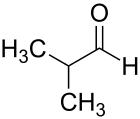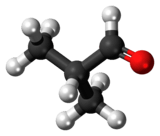Isobutyraldehyde
Isobutyraldehyde is the chemical compound with the formula (CH3)2CHCHO. It is an aldehyde, isomeric with n-butyraldehyde (butanal).[1] Isobutyraldehyde is manufactured, often as a side-product, by the hydroformylation of propene. Its odour is described as that of wet cereal or straw. It undergoes the Cannizaro reaction even though it has alpha hydrogen atom.
 | |
 | |
| Names | |
|---|---|
| IUPAC name
2-Methylpropanal | |
| Other names
2-Methylpropionaldehyde | |
| Identifiers | |
CAS Number |
|
3D model (JSmol) |
|
Beilstein Reference |
605330 |
| ChEBI | |
| ChemSpider | |
| ECHA InfoCard | 100.001.045 |
| EC Number |
|
Gmelin Reference |
1658 |
PubChem CID |
|
| RTECS number |
|
| UNII | |
| UN number | 2045 |
CompTox Dashboard (EPA) |
|
InChI
| |
SMILES
| |
| Properties | |
Chemical formula |
C4H8O |
| Molar mass | 72.11 g/mol |
| Appearance | colourless liquid |
| Odor | Pungent; straw-like |
| Density | 0.79 g/cm3 |
| Melting point | −65 °C (−85 °F; 208 K) |
| Boiling point | 63 °C (145 °F; 336 K) |
Solubility in water |
moderate |
| Solubility in other solvents | miscible in organic solvents |
Magnetic susceptibility (χ) |
-46.38·10−6 cm3/mol |
Refractive index (nD) |
1.374 |
| Hazards | |
| Main hazards | flammable |
| GHS pictograms |   |
| GHS Signal word | Danger |
GHS hazard statements |
H225, H319 |
GHS precautionary statements |
P210, P233, P240, P241, P242, P243, P264, P280, P303+361+353, P305+351+338, P337+313, P370+378, P403+235, P501 |
| Flash point | −19 °C; −2 °F; 254 K |
| Related compounds | |
Related alkyl aldehydes |
Lilial Hexyl cinnamaldehyde |
Related compounds |
Butyraldehyde Propionaldehyde |
Except where otherwise noted, data are given for materials in their standard state (at 25 °C [77 °F], 100 kPa). | |
| Infobox references | |
Synthesis
Isobutyraldehyde is produced industrially by the hydroformylation of propene. Several million tons are produced annually. [2]
Strong mineral acids catalyse the rearrangement of methallyl alcohol to isobutyraldehyde.
It can also be produced using engineered bacteria.[3]
Reactions
Hydrogenation of the aldehyde gives isobutanol. Oxidation gives methacrolein or methacrylic acid. Condensation with formaldehyde gives hydroxypivaldehyde.[2]
References
- Isobutyraldehyde is a retained trivial name under the IUPAC rules.Panico R, Powell WH, Richer JC, eds. (1993). "Recommendation R-9.1". A Guide to IUPAC Nomenclature of Organic Compounds. IUPAC/Blackwell Science. ISBN 0-632-03488-2.
- Boy Cornils, Richard W. Fischer, Christian Kohlpaintner "Butanals" in Ullmann's Encyclopedia of Industrial Chemistry, 2000, Wiley-VCH, Weinheim. doi:10.1002/14356007.a04_447
- Atsumi, Shota; Wendy Higashide; James C. Liao (November 2009). "Direct photosynthetic recycling of carbon dioxide to isobutyraldehyde". Nature Biotechnology. 27 (12): 1177–1180. doi:10.1038/nbt.1586. PMID 19915552.